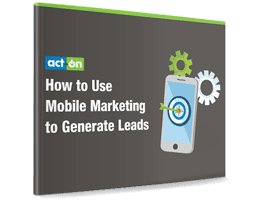 How often do you check social media on your phone? In fact, when was the last time you even got through an entire day without your i-enabled device or Android-powered gadget?
How often do you check social media on your phone? In fact, when was the last time you even got through an entire day without your i-enabled device or Android-powered gadget?
If you’re like most people, it’s quite hard – if not impossible – to recall such a scenario. Living without mobile technology is unthinkable this day and age. And, since our lives are increasingly intermingled with social networks – with 1 billion users around the world accessing Facebook in a single day – life without social media can become quite inconceivable
For the B2B marketer, all this can be summed up in a small yet powerful statement; we need to adapt. A constantly increasing number of people get through their day on smartphones and tablets, remaining connected to social media the entire time. And, as the conventional wisdom of marketing would have it, it’s almost impossible for your business to make inroads without capturing prospects where they are.
Fortunately, while B2B marketers are experiencing the growing pains and a sense of overwhelm that’s prompted by new technologies, there is a way forward. I’ve put together five ways that mobile marketing is affecting social media, along with steps you can take to capitalize on these trends.
Trend #1 – Most people access social media on mobile devices
The ubiquity of social media usage, especially on mobile devices, can’t be overstated. In 2014, it was found that 71% of social network users accessed those networks through a mobile device. In response to this trend, all of the major social networks are reinventing themselves for smaller screens. The most successful marketing efforts will reflect social platforms as presented via mobile technology.
There are a few effective ways to use the mobile formatting of social networks to your advantage:
- Create a compelling header image and bio. Because of the “columnar” fashion in which social networks like Facebook and Twitter render on smaller screens, users will generally see the header image, a short, one-sentence “bio”, and then your company’s content, when visiting your profile page. Because of this hierarchy, make sure the header image you select is visually striking and relevant, and that your “bio” is an attention-getting tagline that speaks powerfully about your brand.
- Use shareable content, like images and videos. According to a recent study, 65% of executives visit a vendor’s site after seeing a video. Visual elements, such as pictures and video, are paramount for lead engagement in both the mobile and social space. Use eye-catching images that offer insight into your brand. Think about recording customer reviews of your product or service, or high-level descriptions of the benefits you uniquely to offer your prospects.
Trend #2 – Niche mobile apps are replacing static landing pages
In 2015, your app, instead of a static landing page on your website, can lead directly to a sale. And your prospects might find out about that app through social media.
Such “niche apps” are an exciting development in mobile marketing, particularly because they offer several distinct advantages:
- They are focused on a specific vertical, product or event. Because they’re not intended to target a broad swath of your market, you can develop a mobile app to reach very specific leads. For example, those willing to attend a seminar where you can demonstrate product benefits in person, or primed by your content marketing to make a purchase.
- They are not made to compete with big apps –and they don’t have to. You’re not looking to build the next Facebook or LinkedIn with a niche app. You’re simply reaching prospects who are already interested in very specific information.
- They offer all the marketing advantages of mobile apps in general. You still get to track user interactions with your app and make use of push messages.
Don’t ignore the benefits of using a niche mobile app. If you choose to produce such an app, make sure you provide a great user experience and employ the most effective mobile-optimized copy possible for the greatest ROI.
Trend #3 – News is being consumed more via mobile technology and social media than ever before
The days of the almighty newspaper are well behind us. 63% of Twitter users and the same percentage of Facebook users say that the social networks are major sources of news extending beyond their personal lives.
What does this mean for B2B marketers? Consumers are willing to engage on social networks with news sources that they’ve come to trust. And if your brand is a respected source of industry-related news among your prospects, you can benefit from this trend in mobile and social news-reading.
If you haven’t done so before, publish news-focused blog posts to social outlets (first, make sure that your blog is mobile-friendly). Follow the conventions of successful blogs: use numbered lists, vary sentence structure, use simple yet industry-appropriate language and be concise. Also, look into distributing your content via popular news-aggregation platforms such as Flipboard and Digg.
Trend #4 – Social network users’ choice of platform equals natural market segmentation
While younger people move away from Facebook and Twitter for newer platforms such as Instagram and Snapchat, older executives and managers can be found in a higher percentage on LinkedIn and Google+. Furthermore, the younger the user, the more likely they are to be viewing social media on their mobile phone.
Information like this can be invaluable for your marketing strategy. In the B2B space, you certainly won’t be marketing directly to teenagers, but you might want to think about market segmentation by age. Are you targeting middle managers or executive-level staff? Then, think about the social media platforms more likely used by your primary target prospects. If your target market covers a spectrum of age groups, segmenting them by age in addition to their other characteristics can help you deliver even more targeted content.
Trend #5 – “Interactive” and “native” ads offer better user experience and greater ROI
 Social media is all about choice-driven connectivity: people engage with other people they like and the brands they trust. And, as far as mobile technology is concerned, the average premium smartphone is a Swiss Army knife of entertainment and productivity tools. Put all of that together, and the message is: B2B mobile ads should be built on the backbone of connectivity and intuitive usage.
Social media is all about choice-driven connectivity: people engage with other people they like and the brands they trust. And, as far as mobile technology is concerned, the average premium smartphone is a Swiss Army knife of entertainment and productivity tools. Put all of that together, and the message is: B2B mobile ads should be built on the backbone of connectivity and intuitive usage.
Two types of ads harness this power: interactive ads and native ads. Interactive ads, quite simply, are ads that ask for involvement and feedback from users. Marketers can use these valuable interactions not only to solidify customer relationships, but for behavioral analysis and tweaking, leading to maximized ROI. As examples, Google offers both interactive video ads and interactive interstitial ads (that is, ads within apps) for marketers seeking new levels of lead engagement.
Native ads, on the other hand, involve varying levels of interactivity, but are more focused on providing the user a natural experience with the brand. These ads are designed to look just like regular content inside a platform a user is already engaged with, and are usually labeled in small print as “sponsored” posts. Such ads might appear, for example, in the user’s Facebook News Feed or Twitter stream.
Depending on your business, you might choose to implement interactive ads, native ads, or both. In either case, here’s how to make your mobile ads more effective than ever before:
- Create interactive ads that immerse the user in an experience with your brand. Think of non-disruptive ways users can interact with your brand (e.g., by clicking certain sections of an image or selecting certain videos within a series, creating a “choose your own story” experience).
- Create native ads that make the user’s social experience seamless and useful to them. The key is not to be “salesy,” but useful and relevant. Use conventions that make sense in the context of the social media outlet the ads are posted in—for example, use “Click Like for more info” as a call-to-action in Facebook, and judiciously use hashtags in Twitter. In addition, since native ads can be “shared,” test several variations and look at your metrics to refine your approach.
The marriage of mobile and social media is not one that’s going to end. Think about the trends your company would benefit the most from using, and be sure that your marketing initiatives are taking advantage!
If you want to learn more about leveraging mobile in your marketing plan, take a look at our eBook How to Use Mobile Marketing to Generate Leads. Inside, you’ll learn the complexities behind mobile marketing in the B2B environment and get nine action steps you can take to generate leads with mobile.


